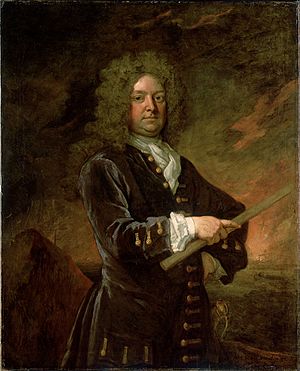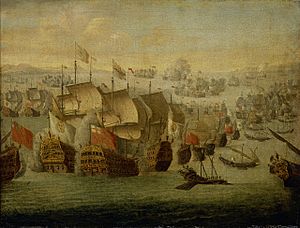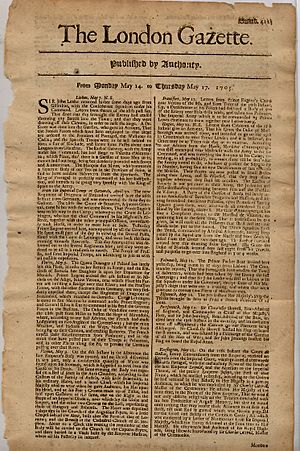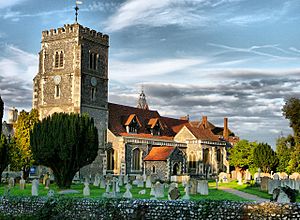John Leake facts for kids
Quick facts for kids
Sir John Leake
|
|
|---|---|

Sir John Leake by Godfrey Kneller
|
|
| Born | 4 July 1656 Rotherhithe, London |
| Died | 21 August 1720 (aged 64) Greenwich, London |
| Buried |
St Dunstan's, Stepney, London
|
| Allegiance | |
| Service/ |
|
| Years of service | 1673–1714 |
| Rank | Admiral of the Fleet |
| Commands held |
|
| Battles/wars | Third Anglo-Dutch War Nine Years' War War of the Spanish Succession |
| Other work | MP for Rochester |
Sir John Leake (born July 4, 1656 – died August 21, 1720) was a brave officer in the Royal Navy and later a politician. He became an Admiral of the Fleet, which is a very high rank in the navy.
As a young officer, he fought in the Battle of Texel during the Third Anglo-Dutch War. He became famous for leading ships that broke through a barrier at Culmore Fort. This helped end the siege of Derry during the Williamite War in Ireland. As a captain, he fought fiercely in the Battle of Barfleur and helped attack French ships at the Battle of La Hogue during the Nine Years' War.
Later, Leake became the Commander-in-Chief of Newfoundland. As a senior officer, he was second-in-command to Admiral George Rooke when they captured Gibraltar. He also led the front line in the Battle of Málaga during the War of the Spanish Succession. He returned to Gibraltar with a large fleet and defeated the French commander Baron de Pointis at the Battle of Cabrita Point.
Leake also helped in the siege of Barcelona and was there when the city surrendered. When Barcelona was attacked again, Leake's arrival made the Franco-Spanish army give up their siege. He later captured Sardinia and helped take the important harbour of Port Mahon on Minorca.
From 1708 to 1715, Leake was a Member of Parliament for Rochester. He also served as the First Lord of the Admiralty from 1710 to 1712, which meant he was in charge of the entire navy.
Contents
John Leake was born in 1656. His father, Richard Leake, was a master gunner. John joined the Royal Navy in 1673. He served on the large ship HMS Royal Prince and fought in the Battle of Texel in August 1673. This was during the Third Anglo-Dutch War.
When the war ended in 1674, he left the navy for a short time to work on merchant ships. He rejoined in 1676 and became a master gunner on HMS Neptune in 1683.
Rising Through the Ranks
Leake was promoted to commander in September 1688. He took command of the bomb ship HMS Firedrake. He fought in the Battle of Bantry Bay in May 1689 during the Nine Years' War.

In May 1689, Leake became a captain. He was given command of HMS Dartmouth. He became famous for leading ships that broke a barrier at Culmore Fort. This helped end the siege of Derry in July 1689 during the Williamite War in Ireland.
He then commanded HMS Oxford in the Mediterranean in October 1689. In May 1690, he moved to command HMS Eagle. He fought in the very tough Battle of Barfleur in May 1692, where 70 of his men died. Leake also commanded HMS Eagle when it successfully attacked French ships at the Battle of La Hogue later that month.
He later commanded HMS Plymouth for convoy protection in December 1692. Then he commanded HMS Ossory in the Mediterranean in July 1693.
In May 1699, Leake commanded HMS Kent to transport troops to Ireland. In January 1701, he moved to command HMS Berwick. He took command of the large ship HMS Britannia for an expedition to Cádiz in January 1702. He then commanded HMS Association in June 1702.
Commander in Newfoundland
Leake was promoted to commodore in June 1702. He became the Commander-in-Chief of Newfoundland. He sailed with eight ships to attack French fishing harbours and their ships at sea. This was at the start of the War of the Spanish Succession in North America. During this trip, his forces captured or destroyed 51 enemy ships.
Leading the Fleet

In December 1702, Leake was promoted to rear admiral. In January 1703, he became the Commander-in-Chief at Portsmouth. He was promoted to vice admiral in March 1703. He sailed with Admiral Sir Cloudesley Shovell to take troops to Lisbon in Spring 1703. His ship survived the Great Storm of 1703 without serious damage.
Key Battles and Sieges
Leake was knighted in February 1704, becoming Sir John Leake. He was second-in-command to Admiral George Rooke when they captured Gibraltar in August 1704. He also led the front line of ships in the Battle of Málaga later that month.
In October 1704, Leake was asked to help Gibraltar, which was under siege by French ships. He quickly sailed with 20 ships and supplies. In the naval battle that followed, three French ships were captured and two were destroyed. This helped save Gibraltar.
Leake became Commander-in-Chief of the Mediterranean Fleet in January 1705. He returned to Gibraltar with a combined English, Dutch, and Portuguese fleet of 35 ships. They defeated Baron de Pointis at the Battle of Cabrita Point in March 1705. The French and Spanish forces gave up their siege of Gibraltar in April 1705.

Leake also helped Sir Cloudesley Shovell and the Earl of Peterborough at the Siege of Barcelona. He was there when the city surrendered in October 1705.
Another siege happened in April 1706. A French and Spanish army tried to recapture Barcelona. But when Leake arrived in May 1706, the enemy army gave up the siege. On his way back, he helped capture Cartagena, Alicante, Ibiza, and Majorca.
Leake was promoted to full admiral and Commander in Chief of the Mediterranean Fleet in January 1708. He was given the authority to fly the flag of an Admiral of the Fleet.
Political Life and Later Service
In June 1708, Leake became a member of the council for the Lord High Admiral. He was elected as a Member of Parliament for Harwich in May 1708 and for Rochester in July 1708. He chose to represent Rochester.
Meanwhile, in the Mediterranean, Leake captured Sardinia in August 1708. He also helped the Earl of Stanhope capture the strong harbour of Port Mahon on Minorca in September 1708.
He was re-appointed Commander-in-Chief of the Navy for an expedition to the Baltic Sea in December 1708. In May 1709, he became Rear-Admiral of Great Britain. He then joined the Board of Admiralty as the Senior Naval Lord in November 1709.

In 1710, he donated a new altarpiece and other items for the church at St Mary's Church in Beddington, where he owned a country house.
Leake became the First Lord of the Admiralty in November 1710. This made him the head of the navy. He led expeditions for trade protection in the Channel in January 1711 and for an attack on Dunkirk in April 1712.
He stepped down as First Lord of the Admiralty in September 1712. He then returned to his role as First Naval Lord on the Admiralty Board. He led another navy expedition in March 1713 before leaving the Admiralty Board in October 1714. He also left Parliament in 1715.
Sir John Leake died at his home in Greenwich on August 21, 1720. He was buried at St Dunstan's, Stepney. He was known as a "virtuous, humane and gallant man, and one of the greatest admirals of his time."
Family Life
Around 1681, John Leake married Christiane Hill. She was the daughter of Captain Richard Hill. They had one son together.

